Analysis and Real-Time Monitoring of the Influence of Wind Load on a High-Altitude Steel Connecting Bridge with Small Spacing
Abstract
:1. Introduction
2. Basic Information of the Project
3. Establishment of Unidirectional Fluid-Structure Coupling Model
3.1. Fluid-Structure Coupling Method
3.2. Establishment of the Geometric Model
3.3. Setting of the Flow Field
3.4. Mesh Division
4. Flow Field Calculation Results and Analysis
5. Static Calculation Results and Analysis of the Steel Structure Bridge
6. High-Altitude Steel Connecting Structure Overall Lifting Construction Monitoring
6.1. General Idea
6.2. T1–T2 Steel Connected Bridge Overall Pre-Lifting Monitoring Data Analysis
6.2.1. Strain Change Data Analysis of the Elevated Bridge Measuring Point in the First Pre-Lifting Stage
6.2.2. Analysis of Strain Change Data of the Elevated Bridge Measurement Point in the Second Pre-Lifting Stage
6.3. T1–T2 Steel Bridge Overall Upgrade Monitoring and Data Analysis
7. Conclusions
Author Contributions
Funding
Data Availability Statement
Acknowledgments
Conflicts of Interest
References
- Zhang, B. Study on construction technology and wind invasion assessment of steel super high-rise buildings in coastal strong wind environment. Adhesion 2023, 50, 172–177. [Google Scholar]
- Zhu, Q.; Hu, X.; Han, Z.; Ma, R. Research on the wind load effect of the combined system of steel bridge tower and crane. Shanghai Highw. 2022, 2, 26–29+84+165. [Google Scholar]
- Liu, Q.; Zhang, M.; Wang, Y.; Zhu, X. Analysis of equivalent wind load in the construction stage of high-rise buildings. Build. Struct. 2021, 51, 1763–1769. [Google Scholar]
- Jia, Y.; Hao, Y. Wind vibration response analysis of high-rise steel structure. Rural Econ. Technol. 2020, 31, 392–393. [Google Scholar]
- Zhang, Q. Design analysis of high-rise building structure under wind load. Real Estate Guide. 2020, 52–53. [Google Scholar]
- Long, X.; Mao, M.; Su, T.; Su, Y.; Tian, M. Machine learning method to predict the dynamic compressive response of concrete-like material at high strain rates. Def. Technol. 2020, 23, 100–111. [Google Scholar] [CrossRef]
- Su, Y.; Wang, J.; Li, D.; Wang, X.; Hu, L.; Yao, Y.; Kang, Y. End-to-end deep learning model for underground utility localization using GPR. Autom. Constr. 2023, 149, 104776. [Google Scholar] [CrossRef]
- Chen, F.; Zhang, H.; Li, Z.; Luo, Y.; Xiao, X.; Liu, Y. Residual stresses effects on fatigue crack growth behavior of rib-to-deck double-sided welded joints in orthotropic steel decks. Adv. Struct. Eng. 2023, 27, 35–50. [Google Scholar] [CrossRef]
- Zhang, C. The active rotary inertia driver system for flutter vibration control of bridges and various promising applications. Sci. China Technol. Sci. 2023, 66, 390–405. [Google Scholar] [CrossRef]
- Yang, L.; Ye, M.; Huang, Y.; Dong, J. Study on Mechanical Properties of Displacement-Amplified Mild Steel Bar Joint Damper. Iran. J. Sci. Technol. Trans. Civ. Eng. 2023. [Google Scholar] [CrossRef]
- Liang, F.; Wang, R.; Pang, Q.; Hu, Z. Design and optimization of press slider with steel-aluminum composite bionic sandwich structure for energy saving. J. Clean. Prod. 2023, 428, 139341. [Google Scholar] [CrossRef]
- Wei, W.; Cheng, C. Integral lifting technology of long-span connected steel structure. Constr. Technol. 2009, 38, 43–45. [Google Scholar]
- GB50017-2017; Industrial standards of the People’s Republic of China. Code for Design of Steel Structure. China Architecture and Building Press: Beijing, China, 2017.
- Yu, B.; Zhu, X.; Li, D.; Liu, C.; Zhao, Z. Analysis of vehicle body deformation in electrophoresis process based on fluid-structure coupling. Comput. Aided Eng. 2022, 31, 34–38. [Google Scholar]
- Liu, Z.; Li, X.; Yan, J. Vibration characteristics analysis of fixed-free riser based on three-dimensional numerical simulation of fluid-structure coupling. Min. Res. Dev. 2022, 42, 172–176. [Google Scholar]
- Zhang, G.; Wang, S.; Sun, Z.; Xiao, Q. Research progress of fluid-structure coupling numerical methods in ship and ocean engineering. China Ship Res. 2022, 17, 1–22. [Google Scholar]
- Liu, D. Monitoring research on unloading construction process of long-span curved mesh structure. Constr. Technol. 2022, 51, 97–99+103. [Google Scholar]
- Zhang, H.; Zhang, W.; Zhang, Q.; Pei, Y. Digital simulation analysis of construction scheme for long-span steel structure. Eng. Constr. Des. 2022, 129–131. [Google Scholar]
- Yu, G. Research on key issues in construction process of steel truss beam of xiaogera suspension bridge. Chang. Univ. Sci. Technol. 2016. [Google Scholar]
- Sun, F.; Zhu, D.; Zhang, D. Research on de-escalation model of fluid-structure coupling calculation for wind turbine blade. J. Vib. Shock 2021, 40, 175–181+215. [Google Scholar]
- Chen, F.; Tang, B.; Cai, Q.; Li, Q. Research on wind load characteristics and wind pressure prediction of long-span flat roof. J. Vib. Shock 2021, 40, 226–232. [Google Scholar]
- Zheng, D.; Liu, S.; Gu, M.; Quan, Y.; Pan, J.; Zhou, J. Numerical Simulation of wind load on long-span hollow-out grid roof. J. Zhengzhou Univ. 2021, 42, 93–98. [Google Scholar]
- Wang, D.; Li, Y.; Liu, Y.; Shi, S. Analysis of Key Techniques in hoisting construction of large-span complex Steel Structures. Eng. Constr. 2020, 34, 1173–1175. [Google Scholar]
- Sun, G.; Zhu, Q.; Wu, W. Monitoring and analysis of pushing construction of open steel box girder with hill-shaped section. Constr. Tech. 2018, 47, 117–123. [Google Scholar]

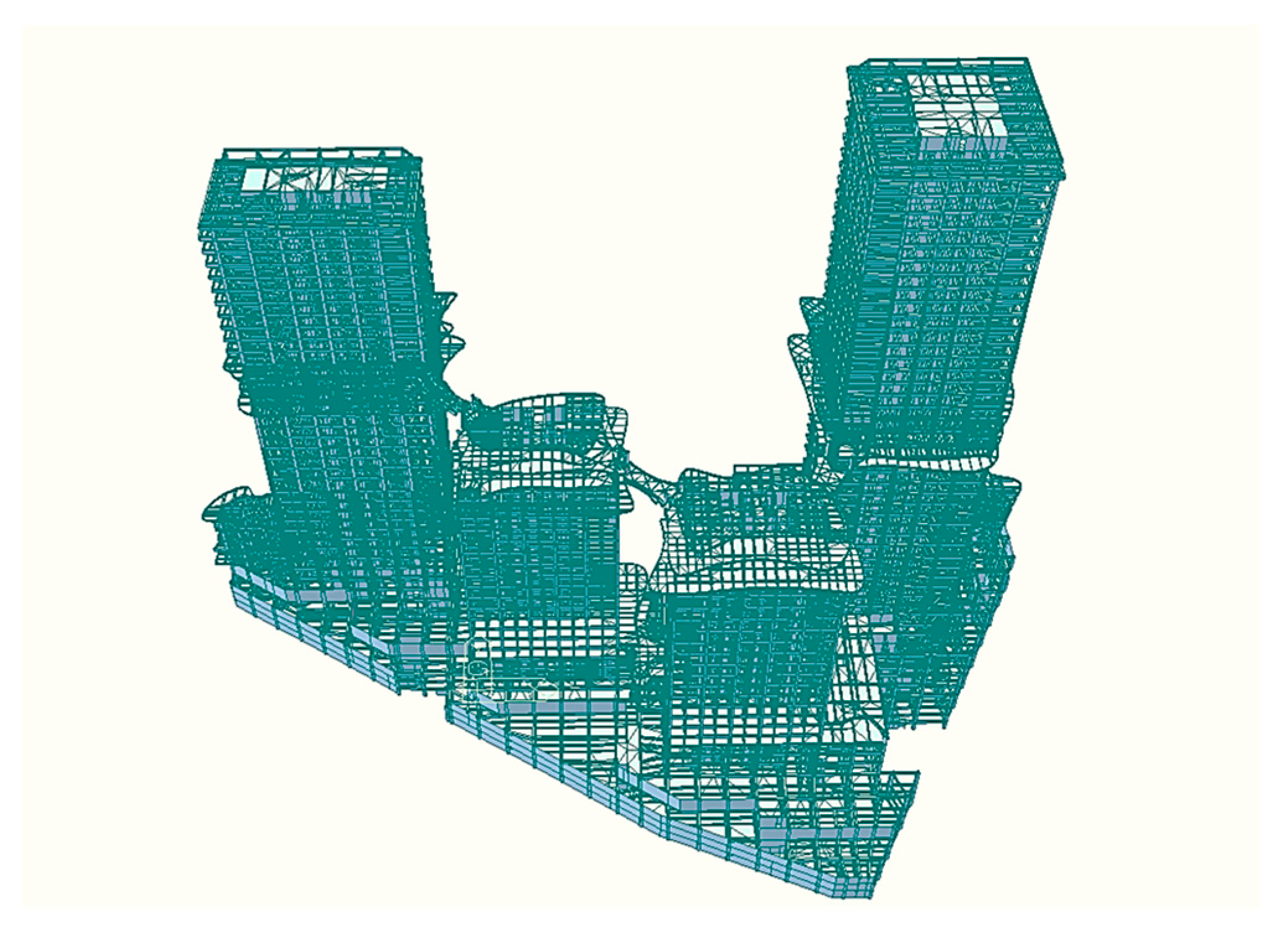
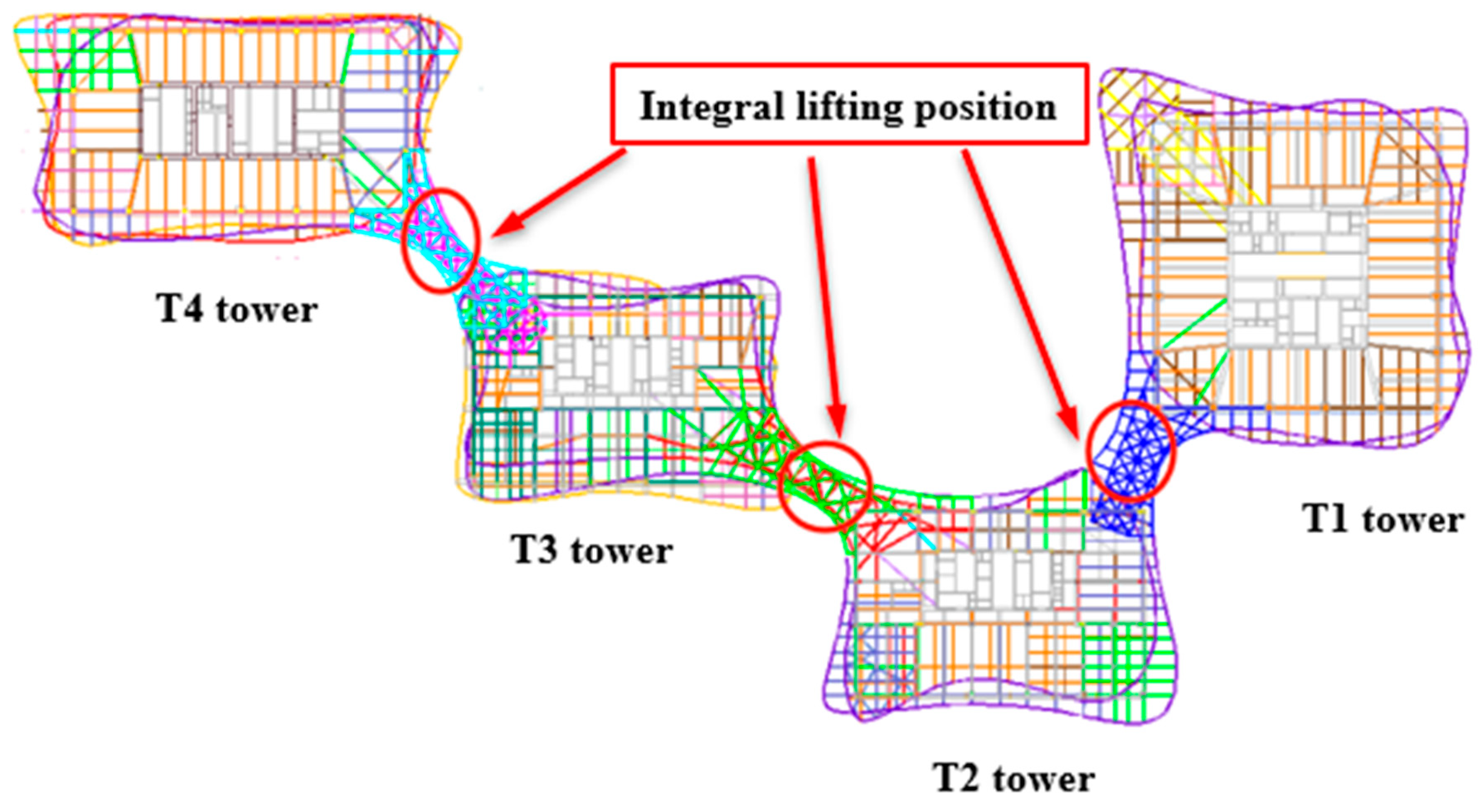
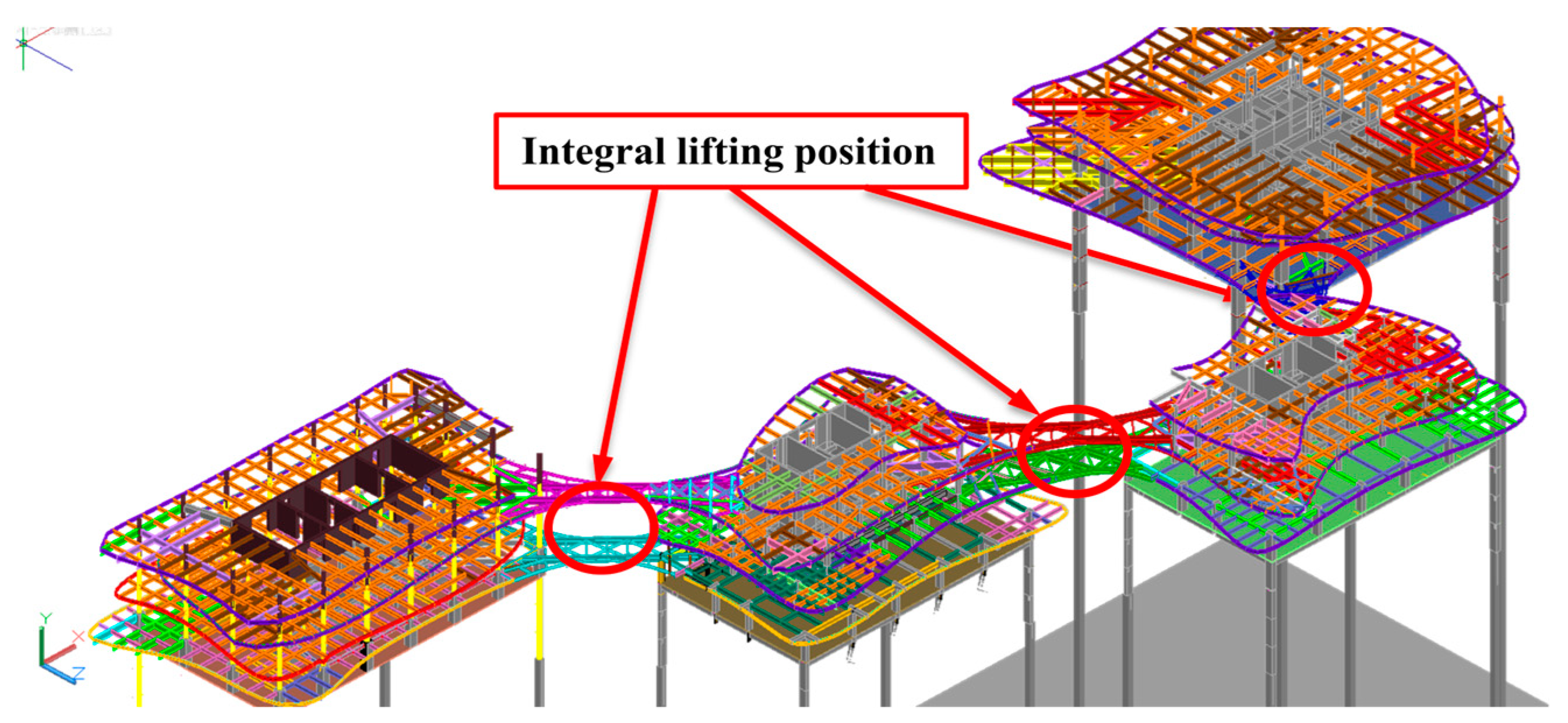
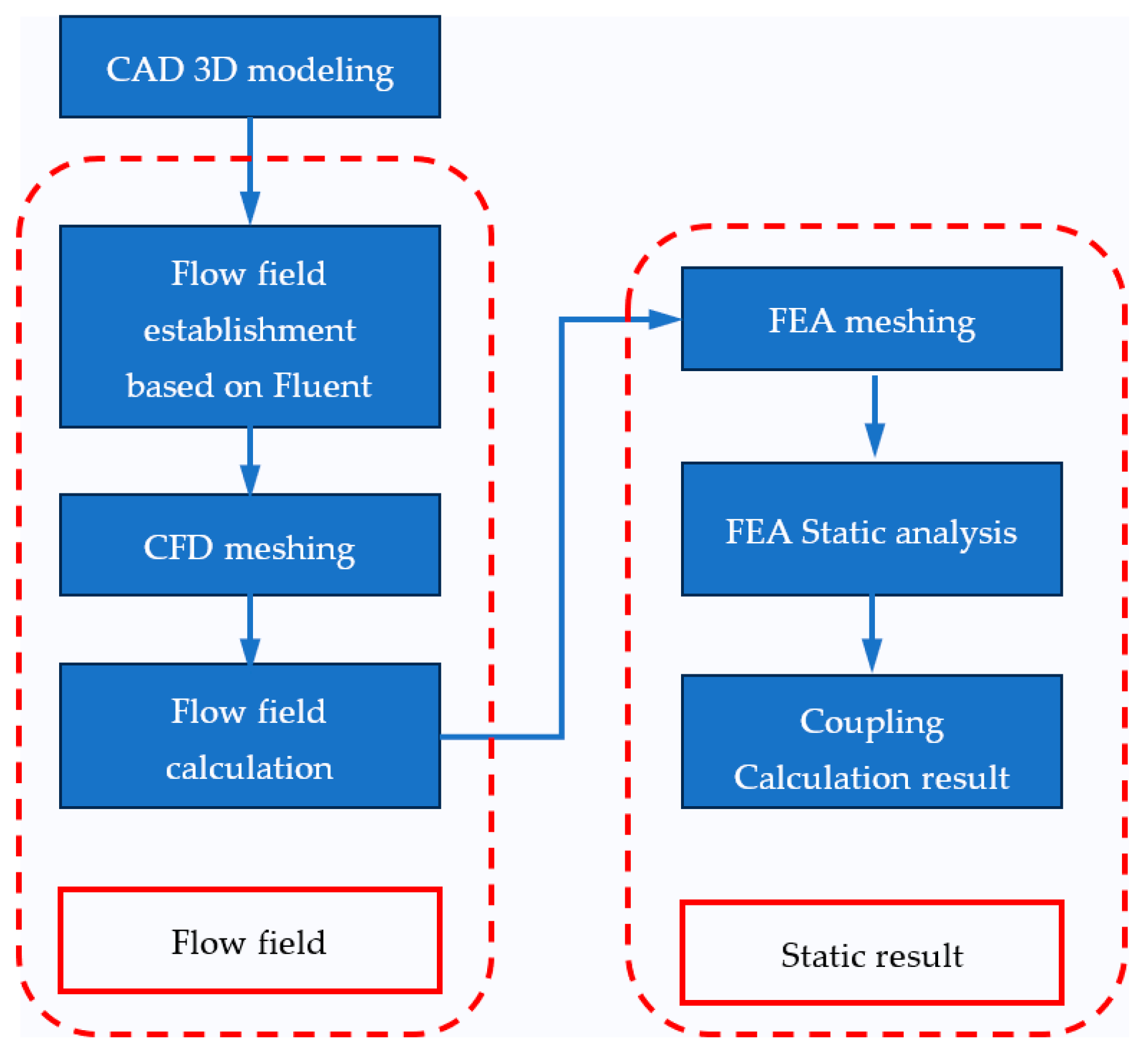



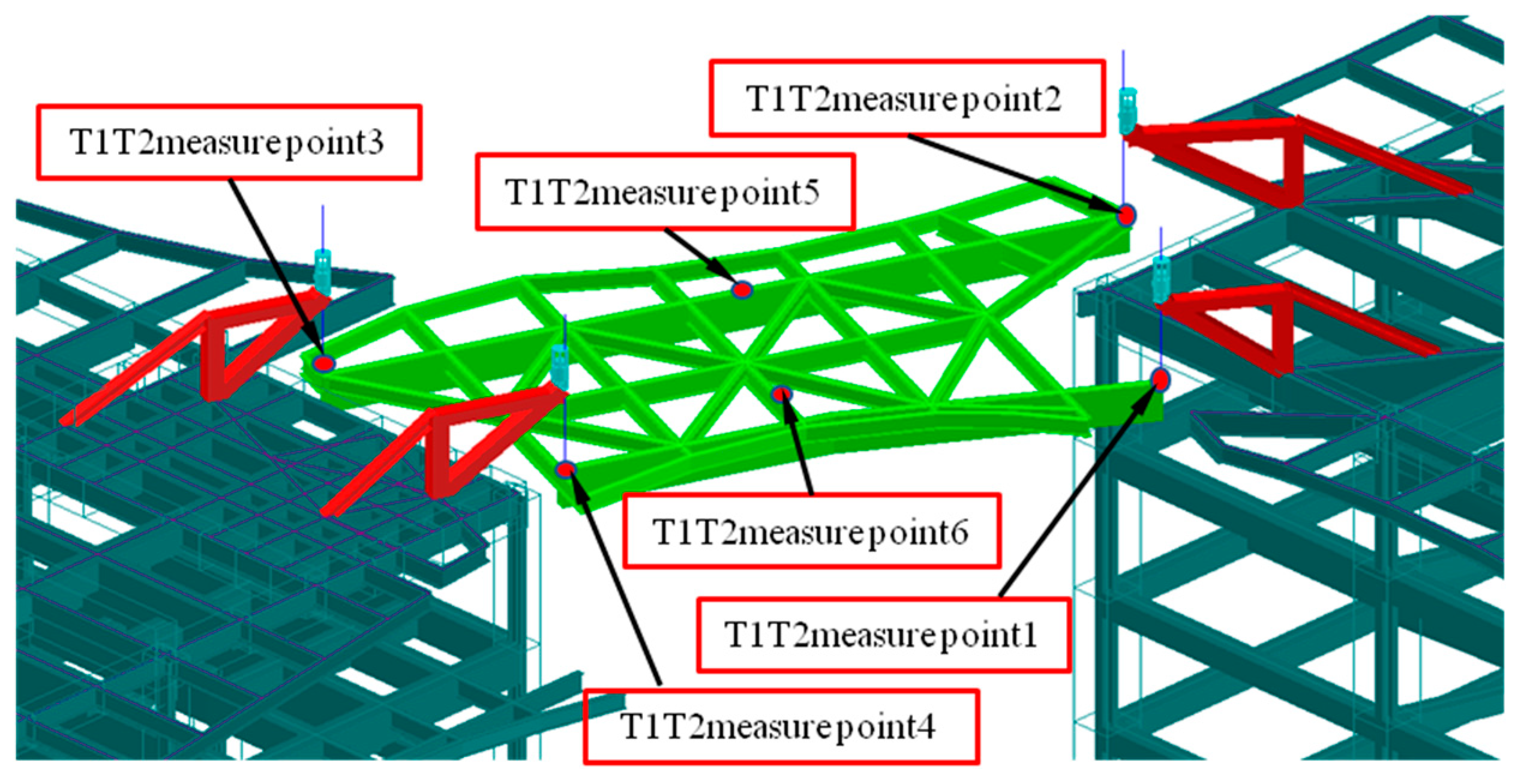
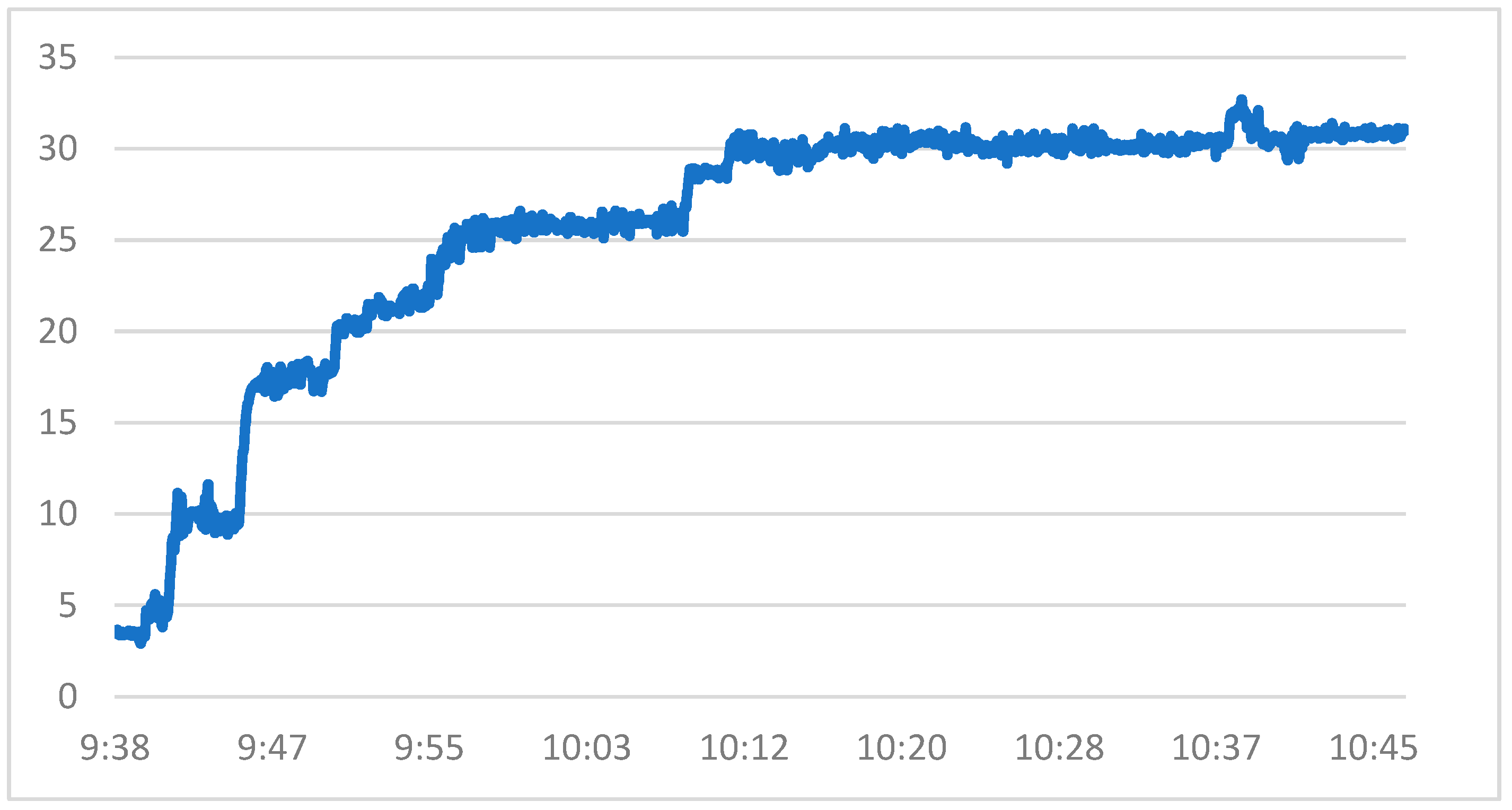
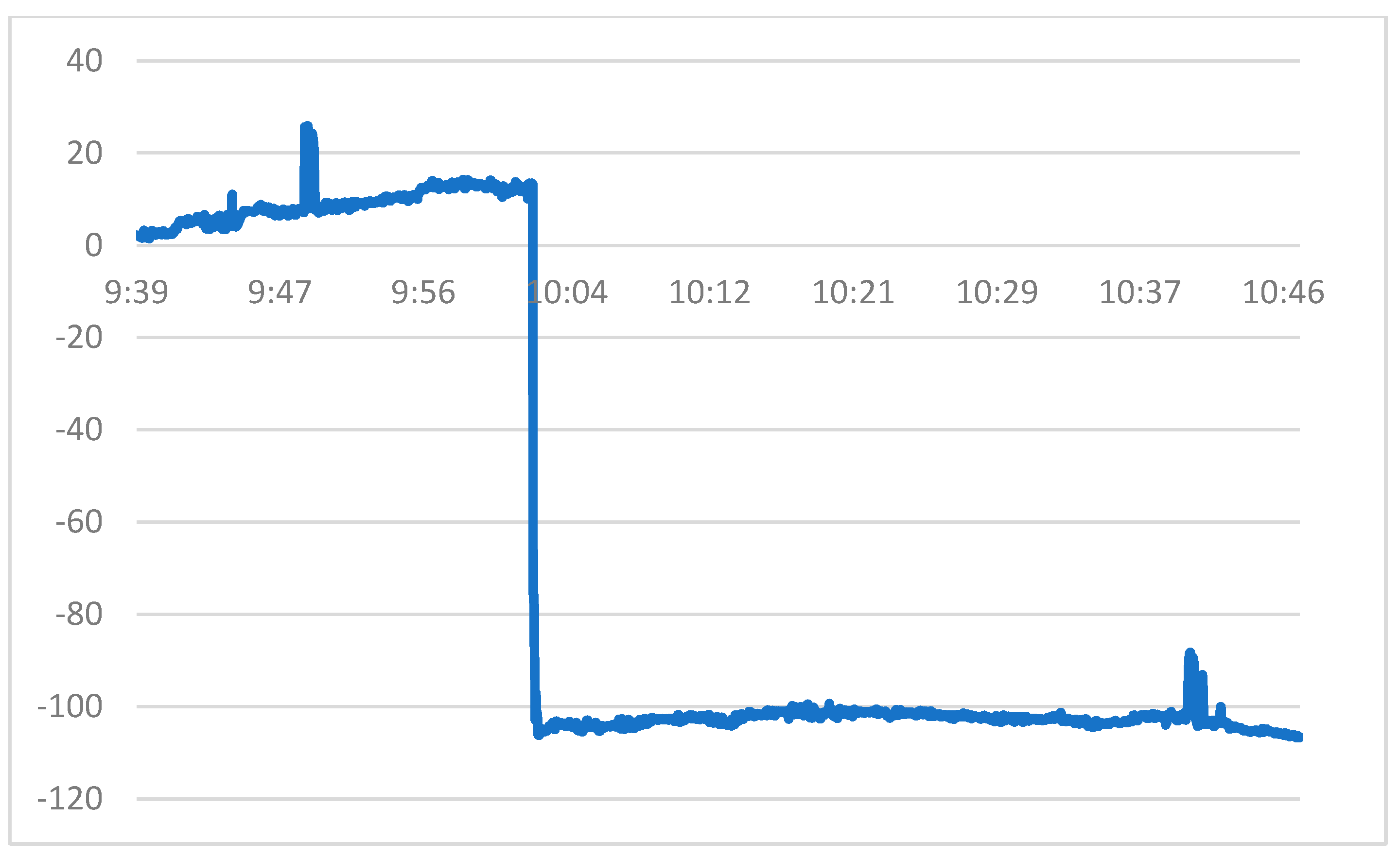
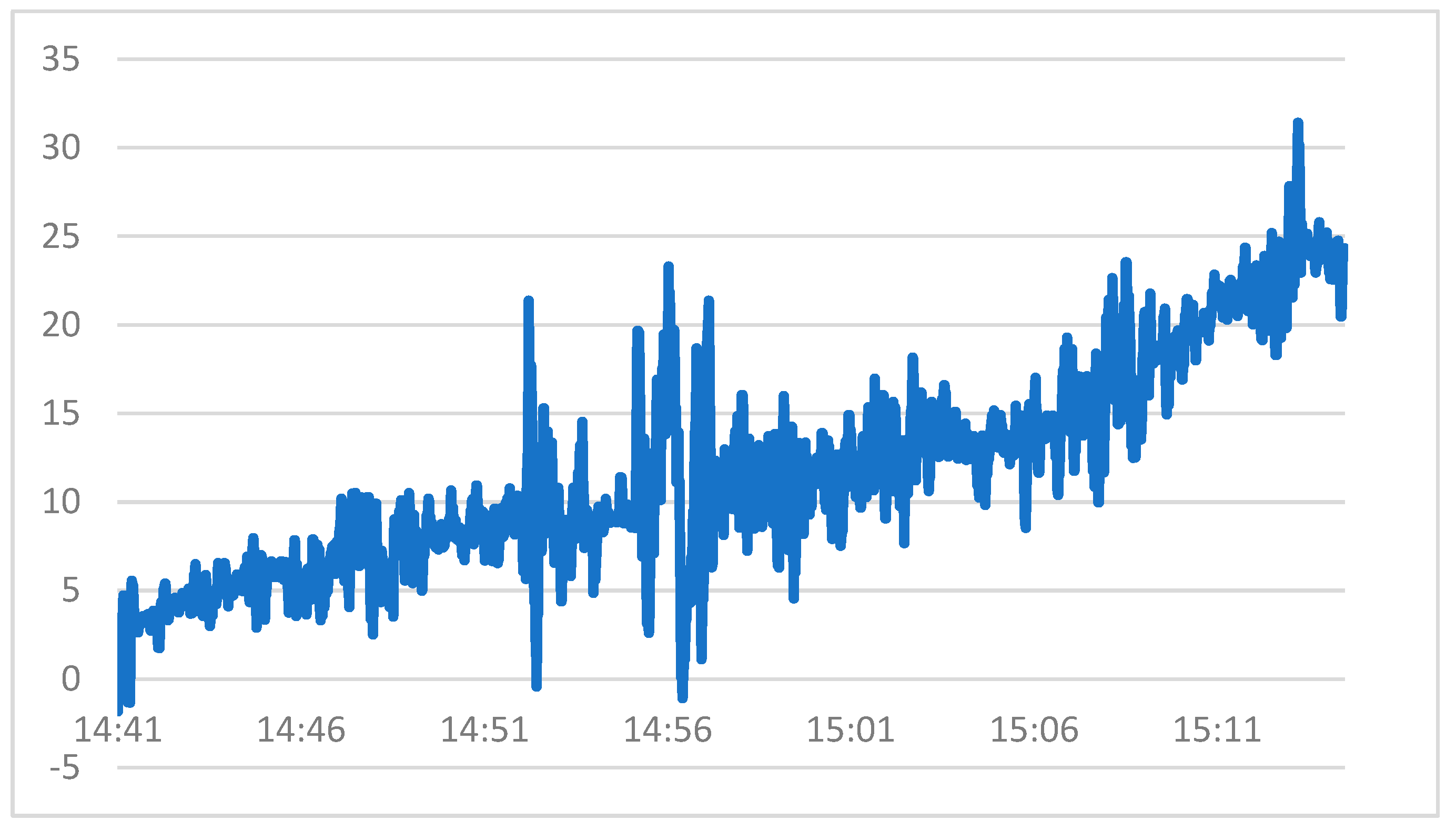
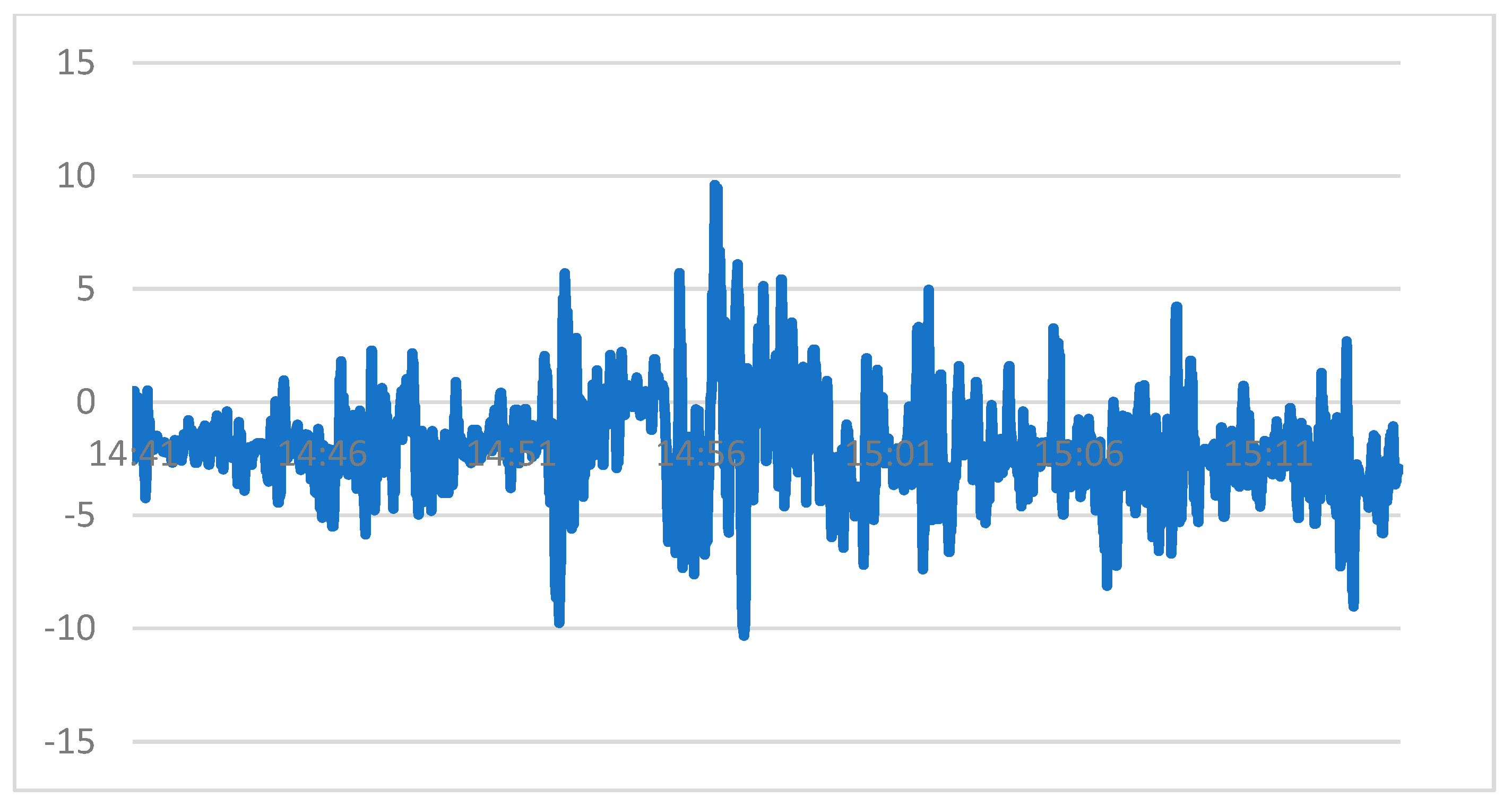
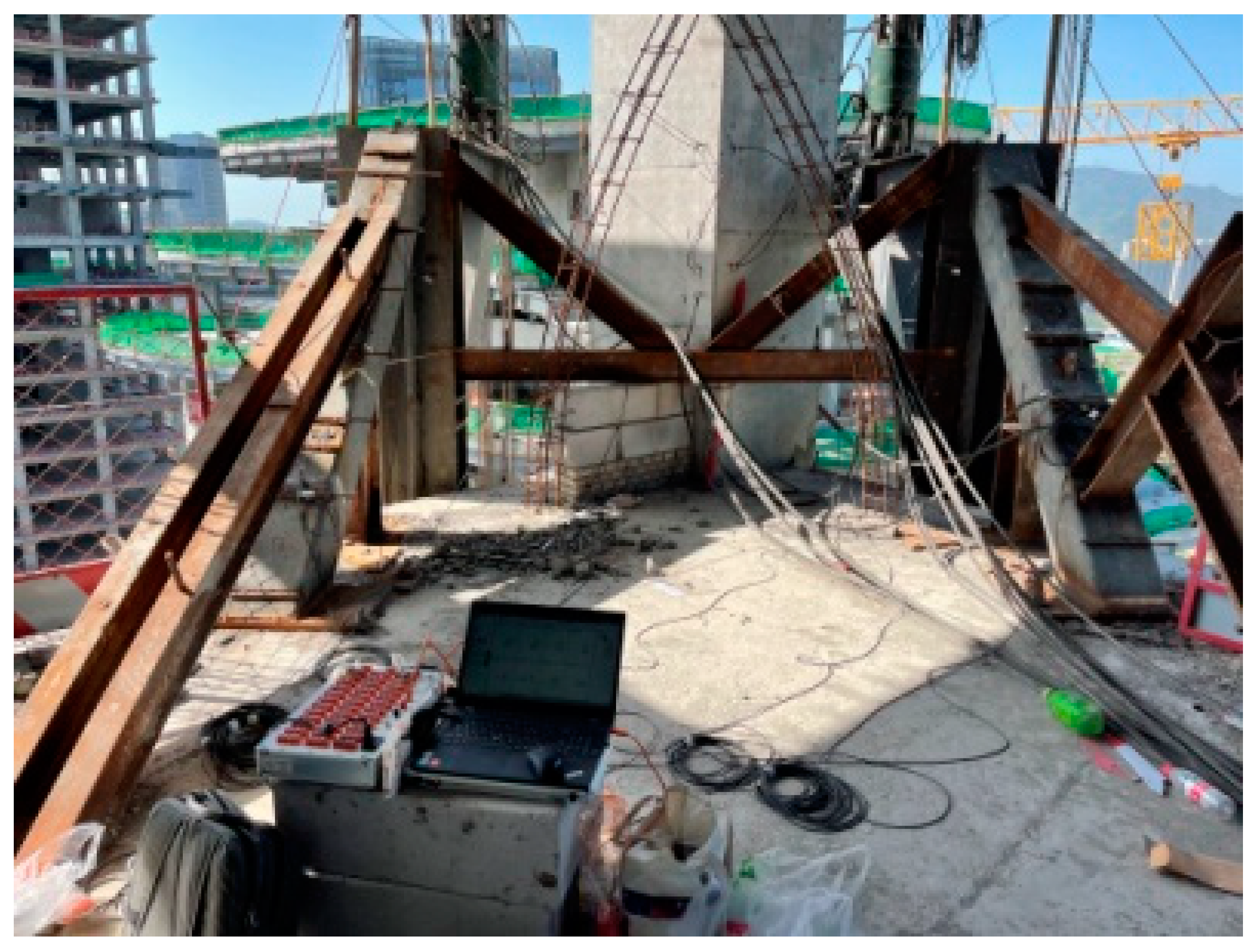
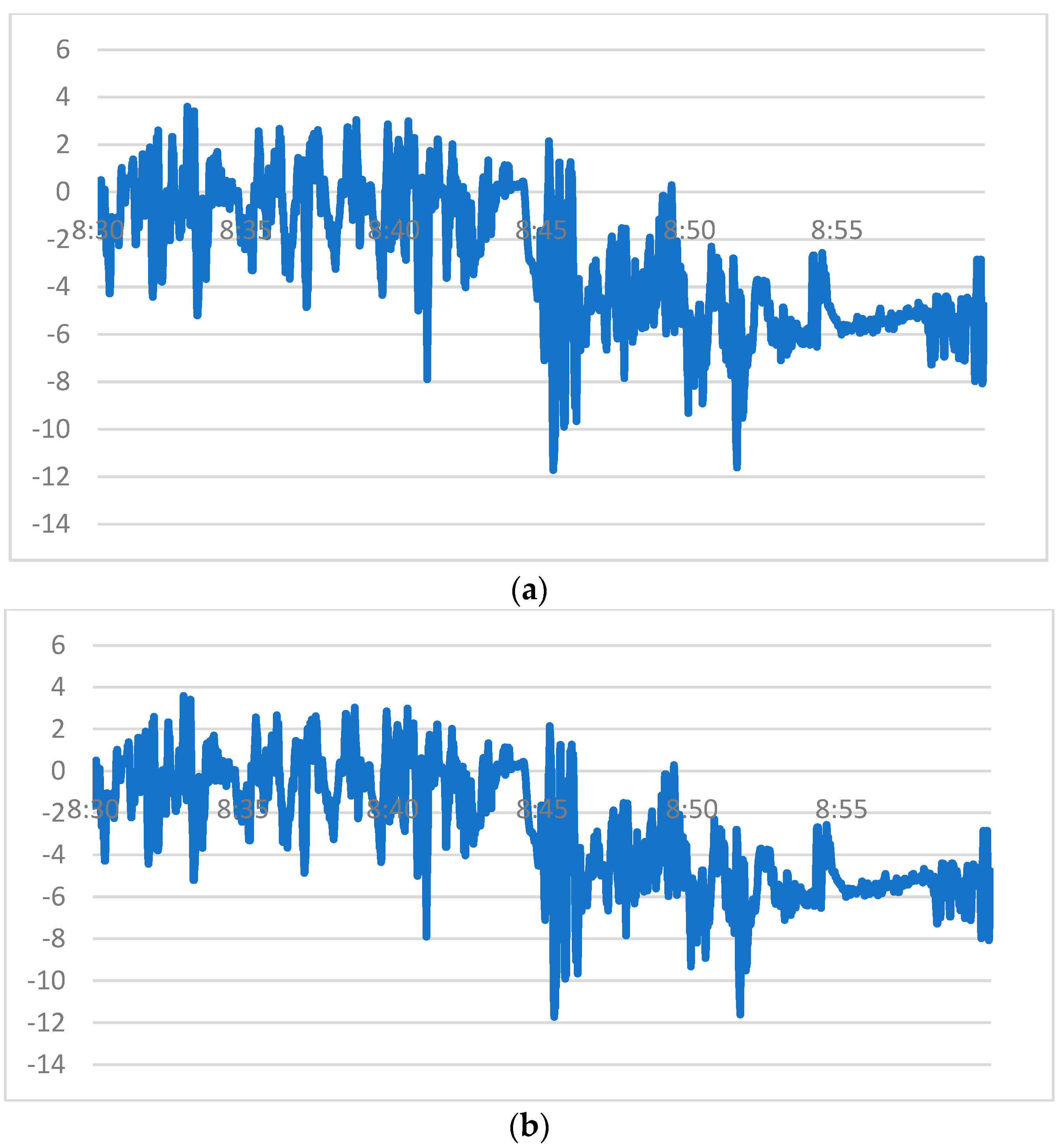
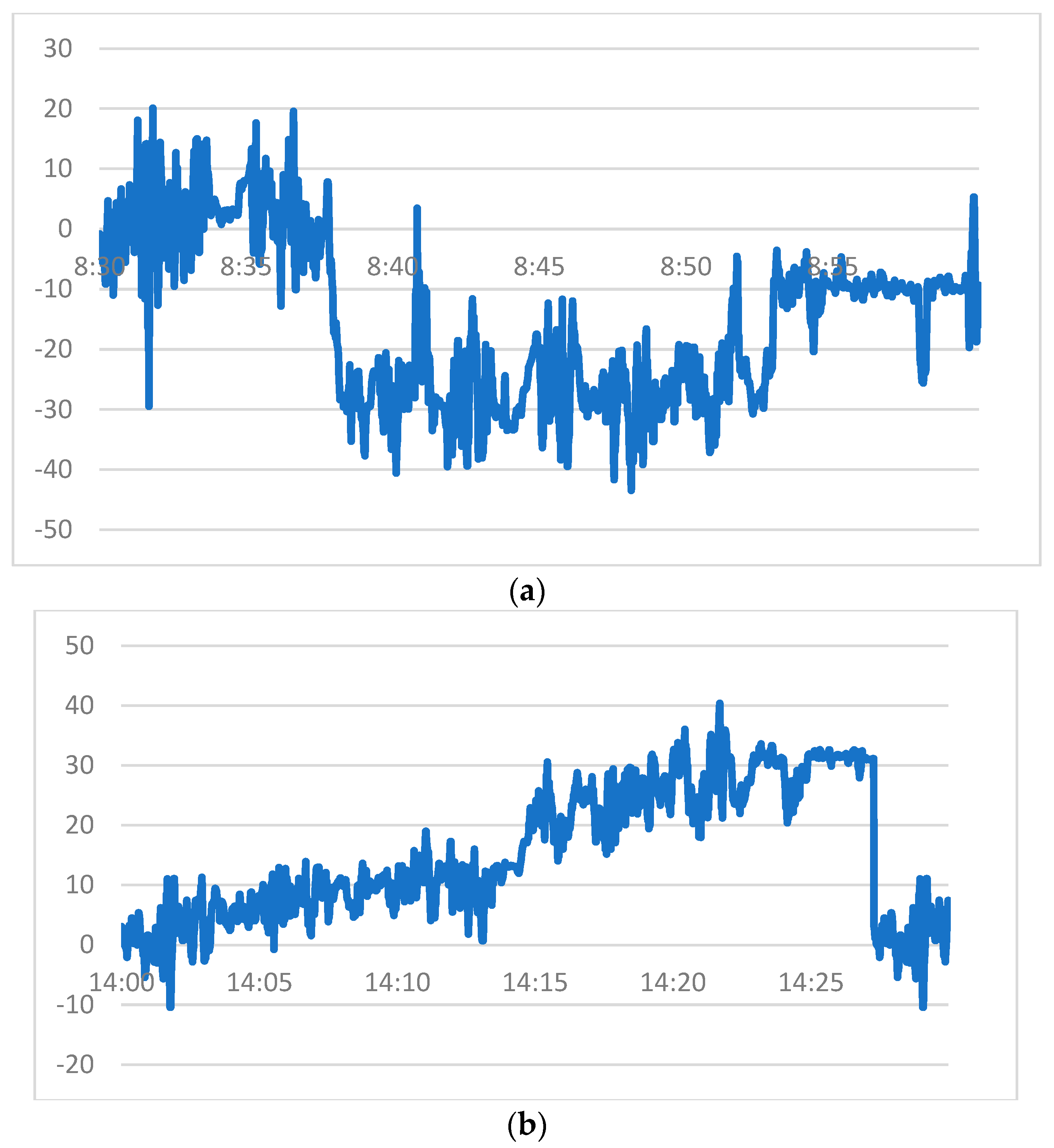
| Table of Materials | Q355B |
|---|---|
| Bulk density (kN·m−3) | 76.98 |
| Tensile strength (N·mm−2) | 470 |
| Yield strength (N·mm−2) | 355 |
| Modulus of elasticity (kN·mm−2) | 206 |
| Unit Number | No. of Nodes | Unit Size |
|---|---|---|
| 849,616 | 150,286 | 0.5 m |
Disclaimer/Publisher’s Note: The statements, opinions and data contained in all publications are solely those of the individual author(s) and contributor(s) and not of MDPI and/or the editor(s). MDPI and/or the editor(s) disclaim responsibility for any injury to people or property resulting from any ideas, methods, instructions or products referred to in the content. |
© 2024 by the authors. Licensee MDPI, Basel, Switzerland. This article is an open access article distributed under the terms and conditions of the Creative Commons Attribution (CC BY) license (https://creativecommons.org/licenses/by/4.0/).
Share and Cite
Wu, X.; Chen, S.; Hu, Y.; Wang, Z.; Li, Z. Analysis and Real-Time Monitoring of the Influence of Wind Load on a High-Altitude Steel Connecting Bridge with Small Spacing. Buildings 2024, 14, 1755. https://doi.org/10.3390/buildings14061755
Wu X, Chen S, Hu Y, Wang Z, Li Z. Analysis and Real-Time Monitoring of the Influence of Wind Load on a High-Altitude Steel Connecting Bridge with Small Spacing. Buildings. 2024; 14(6):1755. https://doi.org/10.3390/buildings14061755
Chicago/Turabian StyleWu, Xinye, Shenghui Chen, Yixin Hu, Zhiwei Wang, and Zhengke Li. 2024. "Analysis and Real-Time Monitoring of the Influence of Wind Load on a High-Altitude Steel Connecting Bridge with Small Spacing" Buildings 14, no. 6: 1755. https://doi.org/10.3390/buildings14061755





